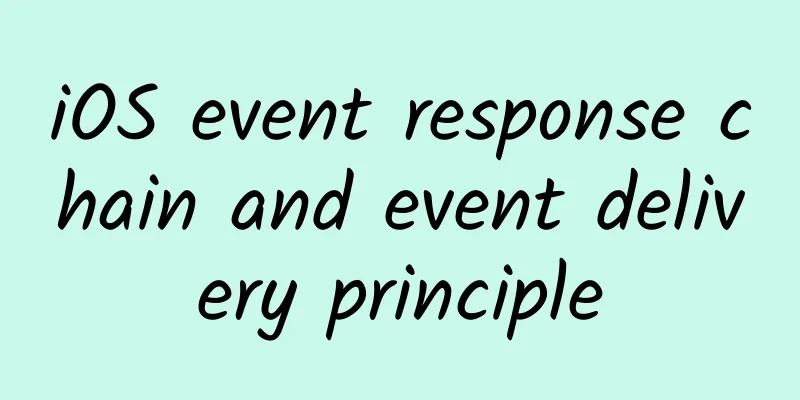iOS event response chain and event delivery principle

|
In iOS applications, one of the core mechanisms for users to interact with the interface is event response. When users touch the screen, click buttons, or perform other operations, the application needs to accurately capture, process, and respond to these events. To achieve this goal, iOS introduces the event response chain and event delivery mechanism. This article will explore the event response chain and event delivery principles of iOS in depth, including its basic concepts, implementation process, code examples, and practical application scenarios. Step 1: What is the event response chain and event delivery?The event response chain is a mechanism that passes events from the event source (such as touching the screen) to the object that ultimately handles the event. In iOS, the event source can be user operations such as touch, gesture, button click, etc. Event delivery refers to the process of passing events from one object to another, which involves event capture, delivery, and response. The event delivery mechanism of iOS is based on the responder chain. Each UI object can become a responder, and they form a responder chain in a certain order. When an event occurs, the system will look for a suitable responder in the responder chain to handle the event. This process is the event delivery. Step 2: The Principle of Event Response ChainThe principles of the event response chain can be divided into the following key steps:
Step 3: Code example of event deliveryLet's use a simple code example to demonstrate the process of event delivery: In this example, we create a ViewController that contains a blue view. When the user touches the screen, both ViewController and MyView implement the touchesBegan method, so they can both become responders to the event. When the user touches the screen, the event is first delivered by the main window. Then, because MyView is at the top of the view hierarchy, it becomes the first responder and receives the event. Then, the event is delivered to ViewController, but only the touchesBegan method implemented by MyView is called, so the touchesBegan method of ViewController is not executed. Step 4: Practical application scenarios of the event response chainThe event response chain is one of the core mechanisms for handling user interactions in iOS applications. The following are some common application scenarios:
Step 5: NotesWhen dealing with the iOS event response chain, there are a few things to keep in mind:
Step 6: SummaryiOS's event response chain and event delivery mechanism are key components for building user interface interactions. By understanding the event delivery process and the principles of the response chain, developers can better handle user operations and achieve rich user interfaces and interactive experiences. The event response chain mechanism allows iOS applications to pass events from event sources to final event handlers when users interact with the interface. The flexibility and scalability of this mechanism enable developers to create a variety of complex user interfaces and implement rich interactive behaviors. A deep understanding of the iOS event response chain and event delivery principle is the key to iOS development. It helps developers better master the implementation of interface interaction and improve the quality of applications and user experience. Whether developing basic button click functions or implementing complex gesture recognition and interface control, understanding the event response chain and event delivery mechanism is crucial. |
>>: Ubuntu 23.10 release episode: ISO image urgently "recalled" due to hate speech
Recommend
Yan Jie 7 steps to get a celebrity back
Yan Jie's 7 steps to get a celebrity back Res...
Honda registers the "Honda e" trademark to signal its entry into electrification
Honda has registered the "Honda e" trad...
The United Nations also celebrates the Spring Festival! The General Assembly resolution designates the Spring Festival as a United Nations holiday
On the 22nd local time, the 78th United Nations G...
Advanced Copywriting Guide | How to be a good copywriter?
Copywriting is not about creating words and sente...
Event operation: How to acquire 220,000 customers at 0 cost!
Taking a recent project as an example (Financial ...
Weird! Watermelon has grown bean sprouts
Recently, a woman in Kaifeng, Henan, was shocked ...
How to build a live broadcast room scene? Tips for setting up a live broadcast room!
Your colleagues will always be your best teachers...
Why do Emoji look different on different platforms?
Why does the same smiling emoji look so different...
Volvo launches new mobility brand M to transform into a mobile travel service provider
On July 4, local time, Volvo Cars launched a new ...
4 channels and strategies for traffic acquisition
In the Internet age, whether it is e-commerce or ...
How can products get more users to pay? Share 3 tips!
When a product enters the mature stage and has en...
How to play with short videos in information flow? 5 ideas + 3 case references!
Advertising has been evolving, have your marketin...
After reading these brand copywriting, let’s talk about what “copywriting tone” is
The first time I heard the word "tonality&qu...
Crocodile: The misunderstood “game”
Some people think that crocodiles are just ugly &...
The fruits in supermarkets are generally good-looking! Is it because they have been added with something "active"?
When you visit the fruit section of a supermarket...









